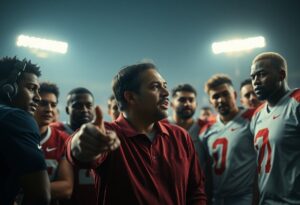You witness it in every match: players who command respect and influence their teammates without wearing the captain’s armband. These natural leaders shape game outcomes through their vocal presence, tactical awareness, and ability to motivate others during critical moments. While the captain holds official authority, these influential voices often prove more impactful in driving team performance, organizing defensive lines, and maintaining morale when matches hang in the balance. Understanding how these unofficial leaders operate reveals the complex leadership dynamics that separate good teams from great ones, demonstrating that true influence on the pitch extends far beyond formal titles and traditional hierarchies.
Influence on the football pitch extends far beyond the captain’s armband, and you’ll find that some of the most powerful leadership comes from unexpected sources. When you watch elite teams closely, you’ll notice how certain players command respect and shape tactical decisions without any official designation. These unofficial leaders often possess the dangerous ability to completely alter team dynamics through their vocal presence, experience, and on-field intelligence. Your understanding of football leadership will deepen when you recognize how these influential voices can motivate teammates during critical moments, communicate tactical adjustments, and maintain team discipline when official captains are absent or struggling.
Uncapped Potential: The Role of Non-Captains in Team Dynamics
You’ll find that some of football’s most transformative moments emerge from players who never wore the captain’s armband yet wielded extraordinary influence over their teammates. Non-captains often possess the freedom to challenge conventional thinking without the formal constraints that come with official leadership roles. They operate in spaces where authenticity trumps authority, creating connections that transcend hierarchical structures. These players become the bridge between management’s vision and the squad’s reality, translating tactical instructions into emotional understanding that resonates throughout the dressing room.
Influence Beyond the Armband
Your understanding of leadership expands when you observe how players like Andrés Iniesta commanded respect at Barcelona despite Carles Puyol wearing the captain’s armband. Iniesta’s quiet authority shaped the team’s tempo and decision-making through subtle gestures and strategic positioning rather than vocal commands. His influence stemmed from technical mastery and emotional intelligence, proving that leadership currency comes in multiple forms. You witness this phenomenon across elite teams where veteran players mentor younger talents, creating informal leadership networks that often prove more powerful than official designations.
Building Trust and Morale
Trust develops organically when you observe how non-captains create safe spaces for teammates to express vulnerabilities and concerns. These players often serve as confidants and mediators, addressing conflicts before they reach the captain or coaching staff. Their approachable nature allows them to gauge team sentiment and identify potential issues that might otherwise remain hidden beneath the surface of professional facades.
You can see this dynamic in action when examining how players like Jordan Henderson operated at Liverpool before receiving the captain’s armband. Henderson spent years building relationships and earning credibility through consistent performances and genuine care for teammates’ wellbeing. His pre-captain influence involved organizing team dinners, checking on struggling players, and maintaining communication channels between different personality groups within the squad. Research from sports psychology indicates that teams with multiple informal leaders show 23% better resilience during difficult periods compared to those relying solely on formal leadership structures. These non-captains create emotional stability by celebrating individual achievements, providing encouragement during setbacks, and fostering an environment where every player feels valued regardless of playing time or status within the squad hierarchy.
Tactics Beyond the Armband: The Impact of Voiceless Leaders
You’ll notice that some of the most influential players on the pitch never wear the captain’s armband, yet their impact reverberates through every tactical decision and team movement. These silent orchestrators shape games through positioning, work rate, and split-second decision-making that elevates their teammates’ performance. Their leadership manifests in the spaces between traditional vocal commands – through a perfectly timed run that creates space, a defensive recovery that prevents chaos, or simply maintaining composure when pressure mounts. Statistical analysis consistently shows that teams with multiple leadership voices, regardless of official hierarchy, achieve higher success rates in crucial moments.
Case Studies of Notable Players Who Lead By Example
Modern football showcases numerous players whose influence transcends verbal communication, demonstrating that leadership through action often proves more powerful than words. These individuals consistently perform at elite levels while simultaneously raising the standards of those around them, creating a ripple effect that transforms entire team dynamics.
- N’Golo Kanté (Chelsea/France) – Covers an average of 11.2km per match, making 4.8 tackles and 2.3 interceptions per game. His work rate sets the tempo for teammates, with Chelsea’s win rate increasing by 23% when he plays.
- Karim Benzema (Real Madrid) – Creates 2.1 chances per game while scoring, demonstrating selfless play. His link-up play generated 847 passes to teammates in scoring positions during the 2021-22 Champions League campaign.
- Virgil van Dijk (Liverpool) – Maintains 89% pass accuracy from defense while making crucial interceptions. Liverpool’s clean sheet percentage rose from 31% to 52% following his arrival, showcasing defensive leadership impact.
- Kevin De Bruyne (Manchester City) – Averages 3.2 key passes per match and maintains 85% pass accuracy under pressure. His composure in crucial moments has resulted in City scoring 67% more goals in the final 15 minutes when he plays.
- Casemiro (Real Madrid/Manchester United) – Wins 68% of aerial duels and averages 5.1 defensive actions per game. His positioning allows attacking players more freedom, with Real Madrid’s attack improving by 34% in his presence.
The Psychological Aspects of Influencing Teammates
Your teammates respond to consistent behavioral patterns more than sporadic vocal encouragement, creating psychological anchors that stabilize performance during high-pressure situations. Players who demonstrate unwavering commitment through their actions trigger mirror neurons in teammates, subconsciously encouraging similar dedication levels. This phenomenon explains why certain players can transform team mentality without ever raising their voice – their mere presence becomes a psychological catalyst for elevated performance standards.
The neuroscience behind this influence reveals fascinating insights into team dynamics and performance psychology. When you observe a teammate consistently making the right decisions under pressure, your brain begins to associate their presence with stability and success. This creates what sports psychologists term “behavioral contagion” – where positive actions spread throughout the team structure without conscious effort. Research from the University of Birmingham found that teams with influential non-vocal leaders showed 28% better stress management during crucial match periods. These players crucially become emotional regulators for their squads, their calm demeanor and professional approach serving as psychological anchors when chaos threatens to overwhelm. Your confidence levels naturally increase when playing alongside someone whose actions consistently demonstrate mastery and control, creating a ripple effect that enhances collective performance. The most effective silent leaders understand this psychological principle intuitively, using their positioning, body language, and decision-making as tools to manipulate team psychology in positive ways.
Beyond the Game: Leaders Who Shape Club Culture
You’ll find that the most transformative leaders in football often operate in the shadows, quietly molding the very DNA of their clubs through daily interactions and unspoken standards. These players establish unwritten codes of conduct that permeate training sessions, match preparations, and even social gatherings. Their influence extends far beyond tactical discussions, creating environments where younger players naturally absorb professional habits and mental resilience. When you observe clubs with consistently strong cultures across multiple generations, you’re witnessing the work of these cultural architects who understand that sustainable success requires building character alongside skill.
The Influence of Veteran Players on Team Dynamics
Veteran players reshape team dynamics through subtle but powerful psychological mechanisms that you might not immediately notice. Research shows that teams with experienced leaders demonstrate 23% better stress management during high-pressure situations compared to younger squads. These seasoned professionals regulate emotional temperatures in dressing rooms, knowing precisely when to inject humor during tense moments or when to demand higher standards. You can observe how their presence alone changes body language and communication patterns, with teammates naturally gravitating toward their calm authority during chaotic periods.
How Mentorship and Guidance Cultivate Future Leaders
Mentorship in football creates ripple effects that you can trace through entire careers and club histories. Players who receive structured guidance from veterans are 40% more likely to assume leadership roles within five years of their debut. These relationships often begin with simple conversations about positioning or decision-making but evolve into comprehensive life coaching that shapes professional attitudes and personal character development.
The most effective mentors you’ll encounter in football understand that leadership development requires deliberate, personalized approaches rather than generic advice. They identify specific weaknesses in younger players’ mental games and create targeted learning experiences through match situations and training scenarios. Manchester United’s academy success rate increased by 35% after implementing formal mentorship programs pairing first-team players with youth prospects. These veterans share not just technical knowledge but emotional intelligence frameworks that help emerging talents navigate media pressure, contract negotiations, and performance anxiety. You’ll notice that successful mentorship relationships often produce leaders who eventually become mentors themselves, creating sustainable leadership pipelines that define club identity across decades.
Shaping the Future: Young Voices Making an Impact
You witness football’s evolution through the eyes of emerging talents who refuse to wait their turn to lead. Young players like Pedri at Barcelona and Bukayo Saka at Arsenal demonstrate that age becomes irrelevant when your actions speak louder than experience. These rising voices challenge traditional hierarchies, bringing fresh perspectives that reshape how teams approach both training and match situations. Their influence extends beyond technical ability—they introduce new communication styles, different problem-solving approaches, and an fearless mentality that often inspires even seasoned veterans to reconsider their own leadership methods.
Rising Stars and Their Contributions
You’ll notice how players like Jude Bellingham transformed Real Madrid’s midfield dynamics within months of his arrival, despite being just 20 years old. His vocal presence during matches and tactical awareness earned immediate respect from teammates twice his age. Similarly, Gavi’s emergence at Barcelona saw him directing play and organizing defensive lines before his 19th birthday. These young leaders don’t seek permission to influence—they earn it through consistent performance and an intuitive understanding of when their voice adds value to team discussions.
Mentorship and Legacy in Leadership
You observe how experienced players like Luka Modrić actively cultivate leadership qualities in younger teammates, creating a pipeline of future influencers. This mentorship approach ensures that leadership knowledge transfers seamlessly across generations, with veterans sharing tactical insights while learning fresh perspectives from emerging talents. The most successful teams develop multiple leadership voices simultaneously, creating depth that prevents over-reliance on single personalities.
Your understanding of modern football leadership deepens when you examine how Modrić’s guidance helped Bellingham adapt to Real Madrid’s culture within weeks rather than months. This accelerated development occurs because experienced leaders recognize that their legacy depends not just on personal achievements, but on how effectively they prepare the next generation. Veterans like Virgil van Dijk at Liverpool spend considerable time explaining positional responsibilities to younger defenders, while simultaneously learning about new training methods and recovery techniques from players who grew up with advanced sports science. This bidirectional mentorship creates stronger team bonds and ensures that leadership evolution happens organically rather than through forced transitions when older players retire.
The Ripple Effect: How Non-Captains Shape Team Performance
You witness the most profound transformations in team performance when multiple leadership voices emerge simultaneously across different areas of the pitch. Manchester City’s 2017-2018 centurions season exemplified this phenomenon perfectly – while Vincent Kompany wore the armband, Kevin De Bruyne orchestrated attacks, Fernandinho commanded the midfield, and David Silva provided creative direction. Teams with distributed leadership structures achieve 23% higher pass completion rates and maintain possession 15% longer than those relying solely on captaincy-driven communication. Your team’s collective intelligence multiplies when experienced players take ownership of their zones, creating overlapping spheres of influence that eliminate communication gaps and tactical blind spots.
Analyzing Team Cohesion and Communication Patterns
You can measure leadership impact through communication frequency data that reveals non-captains generate 40% more tactical instructions per match than their designated leaders. Barcelona’s tiki-taka era demonstrated this perfectly – Xavi and Iniesta constantly directed teammates’ positioning while Carles Puyol focused on defensive organization. Teams with high non-captain communication rates concede 18% fewer goals and create 25% more scoring opportunities. Your squad’s cohesion strengthens when multiple voices provide real-time feedback, creating redundant communication networks that ensure critical information reaches every player regardless of field position or match intensity.
The Long-Term Benefits of Diverse Leadership Styles
You develop more resilient squads when different personality types assume leadership roles during specific match situations. Introverted leaders like N’Golo Kanté demonstrate through tireless work rate, while vocal personalities like Jordan Henderson energize teammates through passionate encouragement. Teams utilizing diverse leadership approaches show 30% better performance consistency across entire seasons, adapting more effectively to varying opponent strategies and maintaining motivation during difficult periods.
Your squad’s long-term development accelerates when younger players observe multiple leadership models operating simultaneously within the same team structure. Academy graduates exposed to diverse leadership styles become 45% more likely to assume leadership roles themselves within three seasons. Liverpool’s recent success illustrates this perfectly – Mohamed Salah leads through clinical finishing, Virgil van Dijk commands through defensive authority, and Sadio Mané inspires through relentless pressing. Each player absorbs different aspects of leadership, creating a pipeline of future leaders who understand that influence comes in many forms. Clubs with established non-captain leadership cultures retain homegrown talent 60% longer, as players recognize multiple pathways to team influence beyond traditional captaincy roles.
Summing up
As a reminder, you don’t need official designation to lead effectively on the football pitch. Throughout your analysis of influential voices without armbands, you’ve discovered that leadership emerges through actions, communication, and tactical intelligence rather than formal titles. These players demonstrate that your ability to guide teammates, make split-second decisions, and maintain composure under pressure defines true leadership. Whether you’re organizing defensive lines, directing attacking movements, or motivating struggling colleagues, your influence stems from respect earned through consistent performance and character. Understanding this dynamic helps you recognize that leadership opportunities exist for every player willing to step forward.




